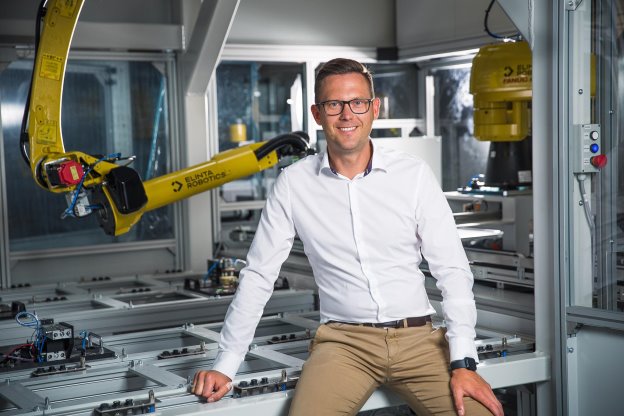AI propels robots beyond repetitive functions

Robotics, a field dedicated to liberating humans from repetitive tasks and enhancing industrial efficiency, is undergoing a remarkable transformation driven by the latest Artificial Intelligence (AI) advancements.
Aurelijus Beleckis, the CEO of Elinta Robotics, the largest robotics company in Lithuania, delves into the evolving landscape of the global robotics industry, highlighting industry trends and the growth of Lithuania’s burgeoning sector.
New markets that invest in R&D expect sector growth
Aurelijus Beleckis, CEO of Elinta Robotics, points out that global robotics market growth has sustained a consistent 15% annual expansion. However, the levels of automation across nations still need to be improved. Notably, Asia, spearheaded by China’s monumental automation investments, has witnessed impressive growth in its robotics sector in recent years. In this context, several new players that have invested in R&D are emerging as dynamic players in Europe.
Elinta Robotics, currently supporting 30% of the Lithuanian robotics industry, is witnessing rapid growth. The company invests around 30% of its resources in R&D. “Five years ago, we started investing heavily in developing the latest technologies such as computer vision and AI. As a result, Elinta Robotics grew five times, while before, the company sustained steady but modest growth of 10%,” says Beleckis. He predicts 30% annual growth for the Lithuanian robotics sector that has a focused commitment to innovation, where robotics companies, including Elinta Robotics, demonstrate unparalleled agility and rapid response, poised to seize opportunities that the ever-evolving AI-robotics convergence offers.
AI’s Rising Influence: The Future Unveiled
The profound influence of AI on robotics is a catalyst for transformative change. Computer vision and AI fusion propels robots beyond repetitive functions, enabling them to learn, adapt, and execute complex tasks. The journey of machines from mere automation to genuine intelligence is reshaping industries. This transition, supported by AI, enhances precision and speed and empowers robots to learn from their experiences.
Beleckis underscores the strategic importance of swiftly harnessing cutting-edge innovations like computer vision. “The integration of AI allows robots to interact with humans more naturally and intuitively, making them ideal for industries such as food, manufacturing, and logistics. Even though the technology is not yet fully mature, AI has already made significant advancements and has transformed various industries in recent years. I think we will see AI’s real explosion after 10-20 years. The technology will profoundly reshape all the industries.”
Greater use of collaborative robots
As the robotics industry continues to evolve, another trend we can see in the coming years is the greater use of collaborative robots. Collaborative robots, or cobots, are designed to work alongside humans in a shared workspace. Unlike traditional industrial robots, which are often isolated and operate behind safety cages, cobots are designed to be safe and user-friendly, allowing for seamless collaboration between humans and machines. The cobot market penetration is expected to surpass 20% by 2032 as the application field for collaborative robots is widening.
“One of the main advantages of collaborative robots is their ability to assist human workers in performing tasks that are either too repetitive or too dangerous for humans to handle alone. Another advantage of collaborative robots is their versatility. Unlike traditional robots, often dedicated to a specific task or process, cobots can be easily reprogrammed and reconfigured to perform a wide range of tasks. This makes them ideal for industries with constantly changing needs and production requirements,” Beleckis points out.
Autonomous Mobile Robots (AMRs) on the rise
An autonomous mobile robot is a type of robot that can comprehend and navigate its surroundings on its own. AMRs do not depend on tracks or predetermined pathways and do not frequently need operator supervision. AMRs navigate around their environment utilizing a complex array of sensors, artificial intelligence, machine learning, and computing for path planning. In 2021, the global autonomous mobile robot market size was valued at $2.2 billion and it is projected to grow at a CAGR of 21.8% from 2022 to 2032.
“AMRs enhance productivity, optimize workflows, and improve safety standards in manufacturing, logistics, warehousing, or any other industry. These robots are a game-changer for businesses looking to optimize their supply chains and reduce costs. We are already in the midst of industrial revolution that emphasizes machine learning, interconnectedness, real-time data, and automation. I am confident that the use of AMRs in various industries will expand exponentially in the near future,” Beleckis says.
The robotic industry is on the brink of significant advancements and transformations as we approach 2024. With the increased integration of artificial intelligence, the rise of autonomous and collaborative robotics, the possibilities for the future of robotics are limitless. “The need to liberate humans from repetitive and dangerous tasks at the workplaces will not disappear, and industrial automation will have its market share,” Beleckis says. “But the boundaries of robotics and AI are being pushed every day. Agility and speed are crucial in this era of innovation, and therefore new markets can emerge as major players in robotics development.”




